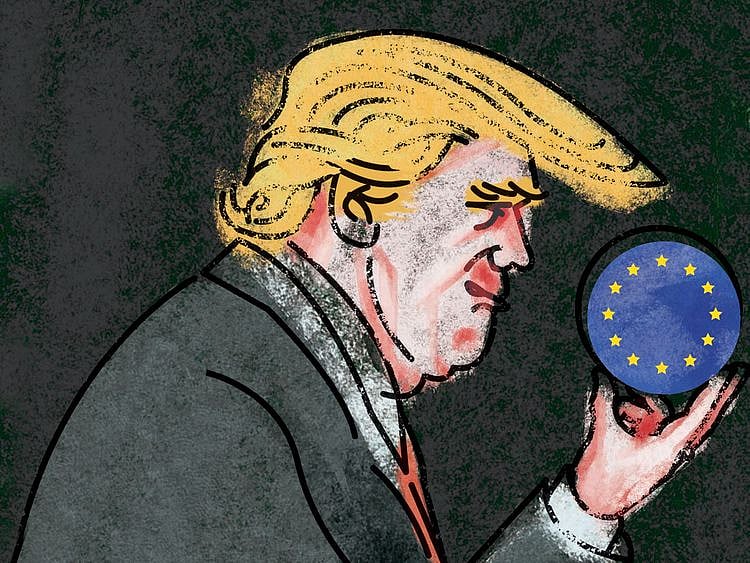US Vice-President Mike Pence finished up on Friday a major tour to Europe visiting countries including Poland, Ireland, and the United Kingdom. With Donald Trump having previously been scheduled to join him in the continent, in what would have been a rare double header visit, this underlines that while this US administration is deeply sceptical about the EU and Brussels, it recognises US interests in the continent, both east and west.
Trump had been planning to visit Poland, in what would have been his second European trip in consecutive weeks, until Hurricane Dorian intervened, which meant he elected to stay in Washington. So Pence took his place in Poland for the 80th anniversary of the Nazi invasion that began the Second World War.
On top of attending those important ceremonies, Pence also travelled to the UK and Ireland. Top of the agenda in Britain was reassuring London of post-Brexit trade ties with Washington, and in Ireland (where some of the vice president’s family descended from) he stressed US commitment to the Irish peace process two decades after the Good Friday agreement.
While Trump and Pence both value US ties with most European countries, the president in particular is deeply sceptical of the EU as an institution. While he has concerns with the continent’s relatively low levels of defence spending vis-a-vis Washington, the economic front is the deepest source of frustration for the president with Europe’s big goods surplus with the United States. And later this year, Washington may launch new car tariffs against the continent.
‘EU is a foe’
The president’s diplomatic disdain for the EU goes significantly beyond that of any his predecessors. Last year, he remarkably declared “I think the EU is a foe, what they do to us [the United States] in trade”. While some have dismissed this remark as just another spur-of-the-moment presidential outburst, Anthony Gardner — who served as US Ambassador to the EU under Barack Obama — has warned that “Europe [needs to] wake-up: the US wants to break-up the EU ... Remember Belgium’s motto L-Union fait la force (Unity creates strength)”.
The contrast here between Trump, with his calls for more “Brexits” within the EU, and US policy at the start of the European integration process could not be starker. Embodied in John Kennedy’s 1962 Atlantic Partnership speech, the core US view then was that a united Europe would make future wars in the continent less likely; create a stronger partner for the United States in meeting the challenges posed by the Soviet Union; and offer a more vibrant market for building transatlantic prosperity.
Yet, US attitudes gradually became more ambivalent as integration deepened, particularly in recent Republican administrations. In the economic arena, for instance, the drive toward the European Single Market led to US concerns about whether this would evolve into a ‘Fortress Europe’. Similarly, the creation of European Monetary Union prompted worries about the dilution of US primacy in the financial sector and macroeconomic policy. Moreover, in competition policy, the increasing assertiveness of the European Commission has periodically raised US concerns about EU over-reach.
Before Trump, the George W. Bush administration came closest to questioning the value of European integration. For instance, the controversy over the Iraq conflict saw Washington querying the benefits of EU collaboration in the security and defence arena. On the eve of the Nato defence review in 2003, US Defence Secretary Donald Rumsfeld even drew a distinction between “old” and “new Europe” with the latter perceived as more favourable to US interests.
However, while the Bush team eventually recognised the need to draw back from this approach, it appears Trump may not be willing to do the same and has indeed raised the rhetoric several notches. In so doing, one of the features of the current president’s approach is an attempt to prise apart Germany and France, the traditional two motors of EU integration.
US-German relations in deep-freeze
Trump’s relationship with Angela Merkel appears exceptionally poor and US-German relations are one of those in Europe that have gone into the deep-freeze since 2017. Here, it is not just the poor mood music between the two leaders, but also the president’s denunciation of Germany which he has called “very bad” because of its significant trade surplus with the United States, and comparatively low defence spending.
By contrast, Trump has warmer relations with Emmanuel Macron, as shown at the G7 recently. In this context, it is reported that Trump advised Macron last year that France would be better to quit the EU to get a better trade deal with Washington than the United States is willing to offer the Brussels-based club as a whole. This remarkable suggestion has no chance of succeeding, and underlines Trump’s poor read of European politics.
While the White House’s gambit in trying to split Germany and France will not succeed, it underlines how US ambivalence about European integration has reached its apotheosis under Trump. While he clearly values relations with some individual European countries, he is the first US president who appears to want to not just weaken, but also splinter, the Brussels-based club.
— Andrew Hammond is an Associate at LSE IDEAS at the London School of Economics
Sign up for the Daily Briefing
Get the latest news and updates straight to your inbox
Network Links
GN StoreDownload our app
© Al Nisr Publishing LLC 2025. All rights reserved.
